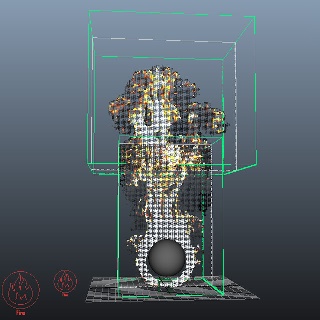These are small and simple tech demos showing different techniques. They are more complicated than the toolbar Quick Setup presets but are simpler than the big Example Scenes.
Droplet Splash
Smoke Inside of Text
The scene uses a few spheres as emitters placed inside of the text. The text is used as Confine geometry so that the simulation is happening only inside its volume. For rendering the Smoke color is set to use the Smoke channel with a blue-green gradient. The text is used as a Cutter Geometry so that only the parts of the smoke that are inside of the text will be rendered.
Gas stove flames
This scene consists of a very simple setup: a Simulator, emitting geometry and a Fire Source. The emissive geometry is an extruded star spline that emits through polygons with the same material. This material is used as an input of the Emit Material option in the Fire Source. Of course, there are plenty of other methods to achieve this result (radial array of smaller geometries for example).
Tweaking of the following options has a significant impact on the final simulation’s result:
- Outgoing Velocity value in the source
- Grid resolution - for this kind of a scene it's pretty low
- Cooling - more cooling leads to shorter flames
- Steps per Frame - high values produce smoother flames
- Volumetric Options - tune the flame's color, light emission, shape and a lot more from here
Smoke color by age
Unlike particles which have an Age channel, the voxel grid does not have such a channel, but it can easily be achieved by using the RGB color grid channel. In this scene, we emit white smoke from a Source, and a Phoenix Mapper using a Black texture Map and a long Buildup Time gradually modifies the RGB channel of the Simulator and darkens the white color over time. This way the oldest smoke has black RGB channel and the newly emitted is white.
The scene uses a cylinder emitting smoke. The Smoke Source has the Temperature set to 10 Kelvins so the smoke will fall down and the RGB channel is enabled with a white color set. The Mapper's Buildup Time is set to 2 seconds. For the rendering the Smoke color is set to be based on Texture and a Remap Color texture is used. The Remap Color texture uses a Phoenix Grid Texture which reads the RGB channel as an input, representing the age, and then the color is remapped to create a ramp from blue for the youngest Smoke which has RGB of 1, through green, to red for the oldest smoke which has RGB of 0.
Hot steam
The scene uses nParticle system as a source with a short particle lifespan. The Smoke Dissipation is set to a value of 0.95 which makes the smoke dissolve quickly. The Conservation is set to PCG Symmetric and the Quality to 40 so we can have a nice swirling motion. The Steps per Frame parameter is set to 4 for compensating the fast moving fluid.
Wind Tunnel
The scene uses Plain Force to create the wind and drag particles to visualize the streamlines. Forward Transfer advection helps keeping the streamlines tight. The particles are emitted using a discharge modifier on the source to make them appear only at certain positions. Also added some Classic Vorticity. You could experiment with PCG or Direct Symmetric conservation. Additionally, you could make the grid completely 2D and use Multi-Pass advection which has a little different feel.
Fire/Smoke Cascade simulation
The scene shows cascading setup between two simulators. The Phoenix Source clamps the texture values between 0-1 so smoke and fuel will naturally transition fine, but temperature which goes above 1 - up to several thousand Kelvin - will need to be remapped before being plugged into the source. This is why the Remap value map is added after the grid texture reading the temperature channel and remapping it in the 0 to 1 range.
- You need to enable Motion Velocity on the Brush source so that the velocities will be transferred as well and of course you need to have velocity exported from the first sim.
- The area which overlaps will be rendered twice, unless you put a box as a render cutter for the first sim.
- Grid-based self-shadowing won't work between the cascade grids - you need to switch to the slower but more robust Ray-Traced self-shadowing.










